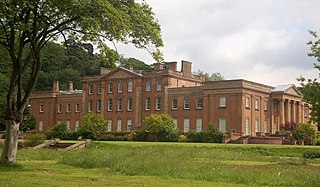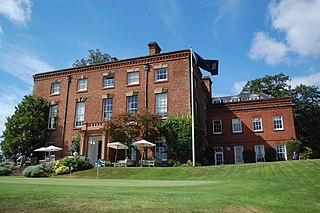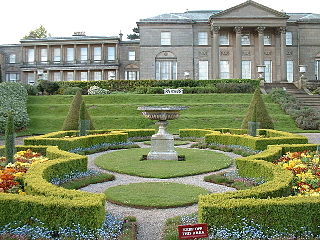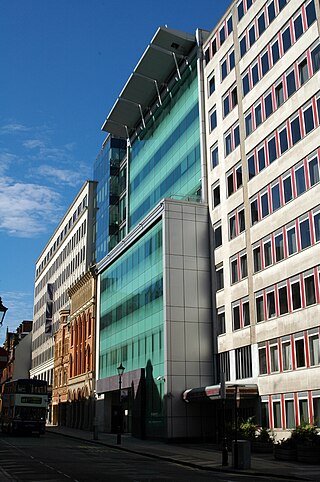
Bretton Hall is a country house in West Bretton near Wakefield, West Yorkshire, England. It housed Bretton Hall College from 1949 until 2001 and was a campus of the University of Leeds (2001–2007). It is a Grade II* listed building.

Croxteth Hall is a country estate and Grade II* listed building in the West Derby suburb of Liverpool, England. It is the former country estate and ancestral home of the Molyneux family, the Earls of Sefton. After the death of the seventh and last Earl in 1972, the estate passed to Liverpool City Council, which now manages the remainder of the estate following the sale of approximately half of the grounds. The remaining grounds, Croxteth Park, were at one time a hunting chase of the Molyneux family and are now open to the public.

Aston Hall is a Grade I listed Jacobean house in Aston, Birmingham, England, designed by John Thorpe and built between 1618 and 1635. It is a leading example of the Jacobean prodigy house.

Key Hill Cemetery, originally called Birmingham General Cemetery, is a cemetery in Hockley, Birmingham, England. It opened in 1836 as a nondenominational cemetery, and is the oldest cemetery, not being in a churchyard, in Birmingham. The principal entrance is on Icknield Street to the west, with a secondary entrance on Key Hill to the north. The cemetery contains the graves of many prominent members of Birmingham society in the late 19th century, to the extent that in 1915 E. H. Manning felt able to dub it "the Westminster Abbey of the Midlands".

Himley Hall is an early 17th-century country house situated in Staffordshire, England. It is situated in the south of the county in the small village of Himley, near to the town of Dudley and the city of Wolverhampton. Himley Hall is a Grade II* listed building. Its park and garden, which were extended in the 1770s by Lancelot "Capability" Brown, are Grade II listed with the National Register of Historic Parks and Gardens.

Edgbaston Hall is a country house in the Edgbaston area of Birmingham, England.

Birmingham Conservation Trust is a charity which saves and restores historic buildings in the city of Birmingham, England.

Elvaston Castle is a stately home in Elvaston, Derbyshire, England. The Gothic Revival castle and surrounding parkland is run and owned by Derbyshire County Council as a country park known as Elvaston Castle Country Park. The country park has 200 acres (0.81 km2) of woodlands, parkland and formal gardens.

Tatton Park is a historic estate in Cheshire, England, north of the town of Knutsford. It contains a mansion, Tatton Hall; a medieval manor house, Tatton Old Hall; Tatton Park Gardens, a farm and a deer park of 2,000 acres (8.1 km2). It is a popular visitor attraction and hosts over a hundred events annually. The estate is owned by the National Trust and is managed under lease by Cheshire East Council. Since 1999, it has hosted North West England's annual Royal Horticultural Society flower show.

Edmund Street is a street located in Birmingham, England.

Highgate is an area of Birmingham, England. Following the Big City Plan of February 2008, Highgate has become a district of Birmingham City Centre. The area is regarded as the site of the original Anglo-Saxon settlement which gave the city of Birmingham its name.

Lytham Hall is an 18th-century Georgian country house in Lytham, Lancashire, 1 mile (1.6 km) from the centre of the town, in 78 acres (32 ha) of wooded parkland. It is recorded in the National Heritage List for England as a designated Grade I listed building, the only one in the Borough of Fylde.

In the early 18th century the Oulton Estate was home to the Egerton family and comprised a manor house and a formal garden surrounded by farmland in Cheshire, England. Later in the century the farmland was converted into a park. The estate is now the site of the motor racing track called Oulton Park.

Thorndon Hall is a Georgian Palladian country house within Thorndon Park, Ingrave, Essex, England, approximately two miles south of Brentwood and 25 miles (40 km) from central London.

Eynsham Hall is a Grade II listed mansion near North Leigh in Oxfordshire, England. The original house dating from the 1770s was largely rebuilt in the early 20th century by Ernest George. After use as a country house and venue for hunting parties it became a maternity hospital rest and relaxation centre in World War II and then a police training centre. It is now used as a hotel and country club.

Wall Hall, originally known as Aldenham Abbey, is a country house at Aldenham in Hertfordshire, England. The main house and several ancillary buildings are Grade II listed. The gardens and parkland are also on the Register of Historic Parks and Gardens of Special Historic Interest in England.

Moseley Hall is a Grade II listed 18th-century country house which was situated in parkland in Moseley, Birmingham. The hall itself is now part of Moseley Hall Hospital and much of the surrounding estate has been developed for roads and housing.

Moor Pool is a 22.32 hectares garden suburb within the ward of Harborne, Birmingham, England. It was designated a Conservation Area in July 1970, which was raised by an Article 4(2) direction order in 2006. A Conservation Area Character Appraisal and Management Plan was adopted in March 2012.

Brabyns Park is a public park in Marple Bridge, Stockport, Greater Manchester, England.




















